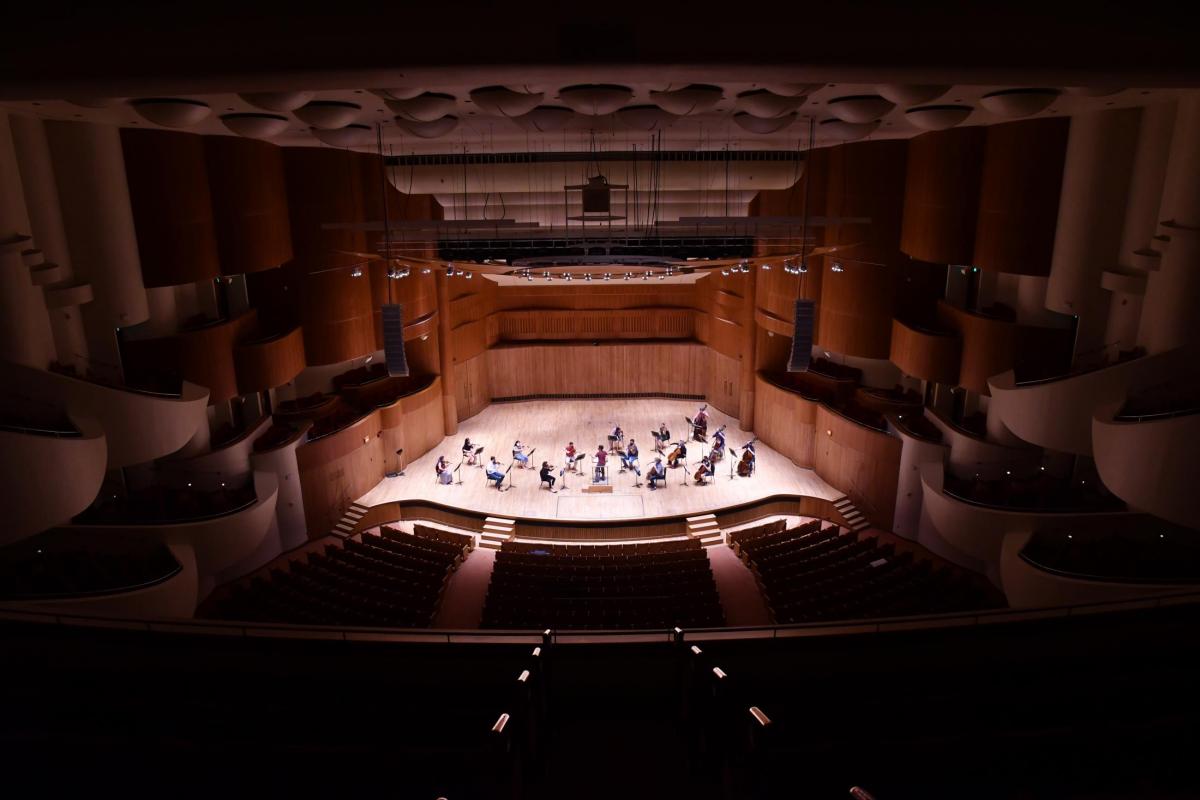
This time last year, musicians gathered outside of the Joseph Meyerhoff Symphony Hall, but instead of instruments, they held picket signs to protest a summer-long lockout and series of contentious contract negotiations at the Baltimore Symphony Orchestra.
This fall, however, it’s a much different scene for the 104-year-old symphony, which has just reached a new five-year agreement between musicians and management—the first long-term contract since the last ended in 2016—marking a new chapter on the eve of their 2020-2021 season.
“It’s an astonishing reversal of fortune,” says percussionist Brian Prechtl, who is also co-chairman of the players’ committee. “There’s a very long history of adversity and distrust at the BSO, but we’re trying to move to a new paradigm—one of collaboration, where the whole is greater than the sum of its parts.”
Even in the midst of the global coronavirus pandemic, which arrived in Maryland just as the bargaining process began again in March, the new agreement creates an unprecedented sense of stability for an orchestra long mired in internal—but rather public—disputes. But the changes afoot are the result of many conversations over the last year, through the recently established “vision committee,” including various stakeholders, from musicians and board members to community leaders, as well as the General Assembly’s mandated state working group. The organization also received advice from “turnaround king” consultant Michael Kaiser, who was hired by the BSO last fall and is credited with helping to revive the American Ballet Theatre, the Alvin Ailey American Dance Theater, and the Royal Opera House in London during times of trouble.
“We’re working together in ways we haven’t in many, many years,” says president and CEO Peter Kjome. “The pandemic may have changed our world, but it hasn’t changed our resolve to share great music and chart the course for the future.”
Due to financial pressures associated with COVID-19, with in-person concerts cancelled through November 29, musicians will take a pay cut this season, starting with a 26 percent decrease in base compensation before gradual increases through 2025, ultimately reaching a minimum annual wage of $90,100—which is more than six percent increase from pre-pandemic salaries. Musicians say this new figure will help retain and attract world-class musicians. And in that vein, the organization will also restore the number of full-time musicians from 75 to 85 over the next five years, moving closer to a peak of 98 in the early 2000s.
“This isn’t some number pulled out of the blue,” says Prechtl, noting that the country’s top orchestras have more than 100 musicians. “It was decided by Tchaikovsky and Brahms and Strauss and Mahler, many, many years ago. That’s what it takes to play the great works of art.”
Also part of the BSO’s five-year contract, and inspired by the Black Lives Matter movement, is the formation of a new task force to address diversity, inclusion, and equity within the organization—which will include examining hiring and audition practices as well as establishing fellowship programs. In early September, assistant conductor Jonathan Rush and artistic partner Wordsmith were appointed to the BSO’s artistic team, joining cellist Esther Mellon as the orchestra’s only African-American artists. Rush, a 25-year-old conducting fellow alum of the Baltimore Symphony Youth Orchestra, will join associate conductor Nicholas Hersh on the podium. Local rapper Wordsmith will serve as an advisor and collaborator, presenting original orchestral projects throughout the season, including an accompaniment to Igor Stravinsky’s The Soldier’s Tale, featuring the perspective of a Black soldier during the civil rights movement.
“We all agree that we need to do more,” says Kjome. “We’re looking forward to welcoming these additional voices to these important conversations.”
All of these changes arrive as part of a broader five-year strategic plan, created with Kaiser and announced in February, which aims to solve the BSO’s financial woes. Earlier this winter, the organization raised upwards of $7 million towards a $15 million, multi-year goal of public and private funds, plus $1.25 million toward its $60 million endowment.
“The stars sort of aligned,” says Prechtl of the donations. “That kind of dedication attracts others who have been waiting to see what will happen. I think more people will step forward. And it’s really important that we now do everything we can to drive contributed revenue, because we’ll have very little earned income to balance the books this year.”
Both the musicians and management agree that the conflict and compromise of 2019 has allowed the BSO, which did receive a Paycheck Protection Program loan, to better weather the calamity of COVID-19.
The orchestra was already operating on a reduced schedule when it pivoted to all online content via its BSO OffStage platform this spring, featuring livestreamed performances, virtual discussions, and podcasts.
February’s strategic initiative had also committed to investing in livestreaming technology, which the BSO will utilize this fall during a brand-new digital concert series, with newly installed robotic cameras bringing the symphony home to an expanded audience. Rehearsals have resumed at the Meyerhoff, but safety protocols are still being solidified, such as smaller ensembles and a socially distanced stage. Aerosols produced during woodwind performances still an area of concern.
“There’s been tremendous innovation during these times,” says Kjome. “While we might not be able to fit all of the musicians on stage for a Mahler symphony, there is some remarkable music we’re going to be performing that our audiences have not heard in a long time, if ever.”
There’s a palpable sense of excitement in the air.
“We’re hopeful,” says Prechtl. “I think we’re on the cusp of the next golden age of the BSO.”
